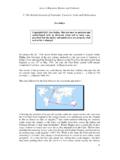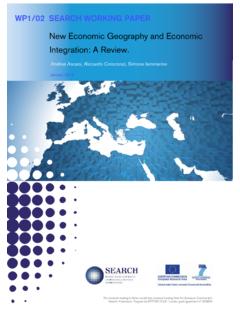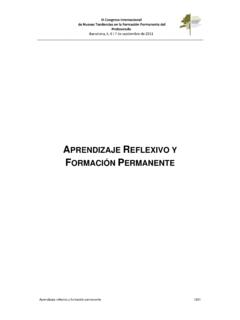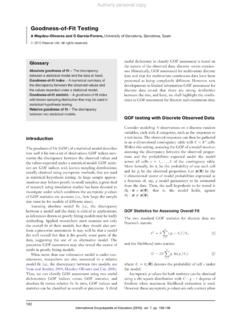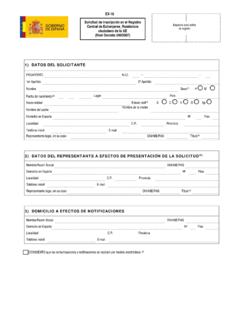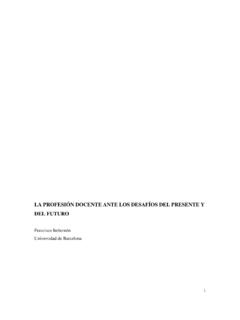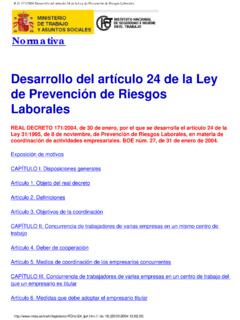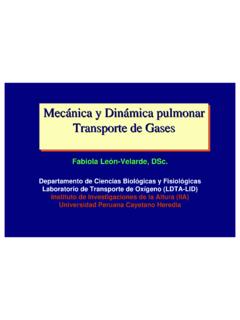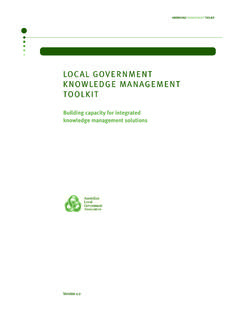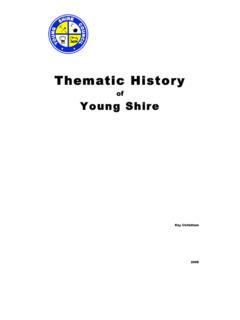Transcription of 3. The Stolen Generations, a Narrative of Removal ...
1 Lives in Migration: Rupture and Continuity 30 3. The Stolen Generations, a Narrative of Removal , Displacement and Recovery Martin Renes The real horror story of Aboriginal Australia today is locked in police files and child welfare reports. It is a story of private misery and degradation, caused by a complex chain of historical circumstance, that continues into the present (Kevin Gilbert 1984 [1978]: 2-3) Today Indigenous Australians assert that rather than referring to a distinct policy governing a specific slice of time, assimilation has persisted as core doctrine in policy-making over the generations from first contact to the present (Anna Haebich 2008: 9) 1. Relocation and dislocation After Europeans massively settled other continents on the waves of capitalist development and expansion, globalisation has made Europe a receptor rather than source of migrants.
2 Its increasingly ethnically-mixed profile has forced a debate on the nature of Europeanness, and affects the rights and obligations of immigrant populations (Vidal-Folch 2008; Zizek 2010). The appearance of xenophobic parties and the recent right-wing pull in many national parliaments are a clear indication of the vexed nature of European cosmopolitanism and multiculturality. Indeed, it is the complex cultural fit and misfit of migrants within Europe s social tissue and the facilities and constraints influencing this process that call for international points of comparison so as to address how its increasing cultural plurality affects European nationhood, belonging and territoriality. The case of territorial dispossession affecting Indigenous Australia (Aborigines and Torres-Straight Islanders)i over the last two centuries, an instance of forced migration to the margins of white settler society, may speak back to European fears of displacement by the ethnic Other.
3 This chapter analyses the ways in which Australian settler society has dealt with the Aboriginal population in its colonising thrust, and what strategies it has employed to effect Aboriginal cultural and physical displacement from their tribal Copyright 2011 Martin Renes. This text may be archived and redistributed both in electronic form and in hard copy, provided that the author and publication are properly cited and no fee is charged. Lives in Migration: Rupture and Continuity 31 lands in its aim to control vital resources. White frontier violence, the dispossession of ancestral country, the relocation to missions and reserves, child Removal and institutionalisation have all played their role in a process of displacement often considered genocidal. Understandably for what is at stake, genocide has been a controversial term in its Australian application, as the policies of different periods may not tightly fit the official UN definition of the intentional, organised destruction of (part of) a racial, ethnic, national or religious group in a reduced time span, and these differences have been used to deny the overall destructive impact of official policies (Moses 2005: 23).
4 From competing perspectives rival terms such as holocaust, extermination, cultural genocide or extinction have also been used to describe the impact of 200 years of colonisation on the Indigenous-Australian peoples. Yet, the Indigenous law expert Larissa Berendt observes that the political posturing and semantic debates do nothing to dispel the feeling Indigenous people have that [genocide] is the word that adequately describes our experience as colonized people (Moses 2005: 17).ii This chapter will take Berendt s cue in focusing on the plight and testimony of the Stolen Generations, a large group of mixed-descent children forcibly removed at great distances from their Aboriginal families and raised to fit into white society. Their vicissitudes have lately become visible, worded and documented in human-right reports, academic study and artistic and literary work.
5 It is these children that became the main focus of assimilative government action; it is in their defencelessness that the breach of basic human rights is salient; it is also in their current recovery as Indigenous rather than white Australians that the resilience and ongoing presence of the Aboriginal communities and cultures are manifest, as shown in the Bringing-Them-Home Report. After an overview of Australian assimilative policies and these children s location in these, this chapter will address their testimony of diasporic displacement in some representative Indigenous literary output from the state of Western Australia. 2. Unofficial and official policies of dispersal and destruction The process of Indigenous assimilation through geographical displacement has most intensively taken place in the more densely urbanised south of the continent, where most of their extant, part-Indigenous detribalised populations live in urban settings.
6 Less affected have been the continental north and centre, which hold remote communities considered to retain a more traditional and genuine Aboriginal lifestyle and pedigree. Their presumed authenticity , the result of policies of segregation, has been a powerful discursive tool with which the mainstream has written Aboriginality into marginality and off the Australian map; there is no place for their primitivism in contemporary Australian society other than theme park nostalgia. Its counterpart is the assimilative rhetoric which denies the Stolen Generations their Indigeneity and thus a vast but grey area of interculturality. Long considered subhuman, the Aboriginal population did not form part of the Australian census up until the National Referendum of 1967, but reliable estimates hold that at the end of the 19th century they numbered between 60,000 and 80,000 members Lives in Migration: Rupture and Continuity 32 in an uneven spread across the continent, with most of the tribal survivors living in its north and in its central desert.
7 This contrasts sharply with a possible population size of million before white colonisation (Haebich 2000: 138). The 2006 census calculates the Aborigines at a mere of a total Australian population of 21 millions; this amounts to approximately 500,000 people, provided one includes the vast group of mixed descent who increasingly identifies as Aboriginal (Australian Bureau of Statistics 2006: 4). If the latter denotes a substantial recovery from the 1896 statistics, it still falls far below realistic estimated pre-contact counts, and highlights the heavy impact of white civilisation on the original inhabitants of the continent both in the number and composition of Indigenous descent. Aboriginal migratory movement is rooted in colonial defeat, in which the control over tribal land and culture were relinquished in the face of an overpowering migratory wave from abroad.
8 The Aboriginal communities tried to withstand the invasive thrust of British colonisation starting in 1788, but they were unable to fight off the ever-increasing numbers of foreigners who occupied Indigenous territory with new land uses and caused Indigenous dispersal and destruction with superior weaponry and imported contagious diseases. A process of dispersal and forced migration took place in which local Aboriginal communities were pushed to or beyond the margins of their territories by new settlers of Anglo-Celtic origin (Haebich 2000: 67-9). While this migration may seem internal, it is perceived as transnational by Aborigines. They may claim diasporic identities [.. i]nasmuch as their distinctive sense of themselves is oriented towards a lost or alienated home defined as aboriginal (and thus outside the surrounding nation-state) (Clifford 1994: 309, my emphasis, quoted in Pulitano: 40).
9 Indeed, the remnants of the so-called First Nations found themselves decimated, stripped from kin, culture and traditional country, and pushed into fringe habitats of bare subsistence, often outside their homeland. The larger geo-political redefinition of Australia by the non-Indigenous mainstream, who unlike other settler states (USA, Canada, New Zealand) still does not recognise indigenous sovereignty, was endorsed by the Australian Federation in 1901, which created a single nation space of Anglo-Celtic pedigree. Political maps of Settler Australia and Aboriginal Australia < > Access 5 May 2011 < > Access 5 May 2011 Lives in Migration: Rupture and Continuity 33 Traditional mainstream accounts of Australian history present white colonisation as the benign settlement of an empty Terra Nullius an 18th century legal term for a land belonging to no-one (Reynolds 2003: 14)iii and European civilisation as the advent of progress and modernity (Windschuttle 2002; see Manne 2003 and Attwood 2005 for reactions).
10 Yet, these narratives cover up a history of invasion, extermination and violent displacement which pushed local Aboriginal societies out of their self-sustaining hunter-gatherer habitats, causing death, destruction and bare subsistence (Cf. Reynolds 2003: chapters 4-8). The indiscriminate frontier violence of the 19th c. sought to clear tribal land for market purposes, and left an indelible mark on Indigenous Australia, forcing Aboriginal relocation from tribal land to cattle stations, mission-reserves and town fringe camps. In the first half of the 20th century, Aboriginal displacement was re-enforced and institutionalised by state policies of dispossession and Removal inspired by late-Victorian eugenics, which foresaw no viable future for primitive man in the face of Europe s civilisation and racial superiority.
